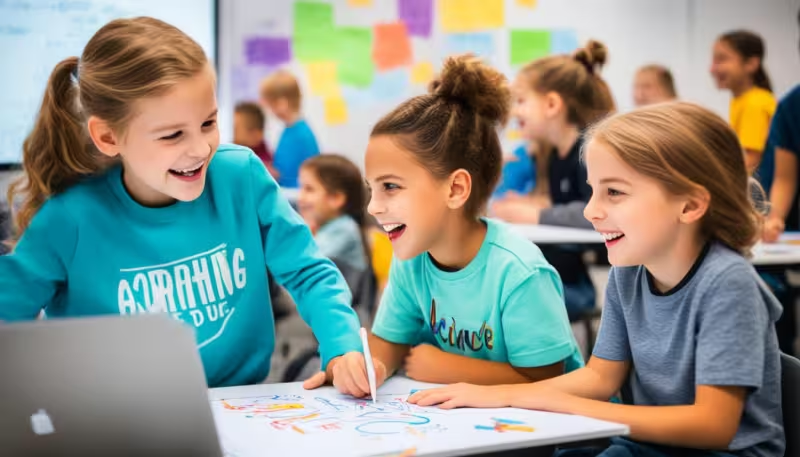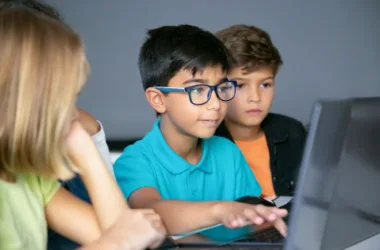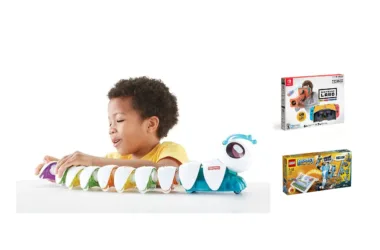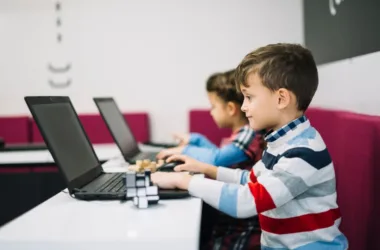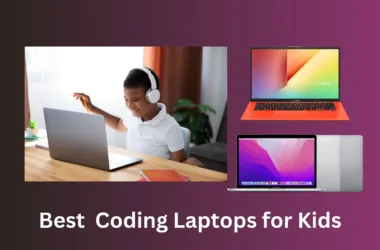Ever thought how a line of code could turn a story interactive? In the digital world, combining coding with storytelling is exciting for kids. It brings creativity and learning to a new level. Coding boosts kids’ problem-solving and communication. It also grows their imagination and reading skills.
Let’s explore how to make stories interactive. We will share tips and steps for kids to create their own tales. It’s fun and educational. Through projects like TechnoTales, they see coding as a way to express themselves. They learn storytelling can be fun and includes important lessons in math and reasoning. Come with us to discover how to tell tales in an innovative way.
Introduction to Coding and Storytelling
Coding and storytelling are key to sparking creativity. They both require understanding coding basics and storytelling fundamentals. As our world leans more on technology, coding breathes life into stories. It makes them interactive and engaging.
Starting with beginner coding helps students craft their stories. Tynker is a popular platform in over 150,000 schools. It has coding courses for all levels, from simple icon-coding to Python and JavaScript. With Tynker, kids learn to solve problems and code, boosting their confidence and independence.
Coding and storytelling together result in amazing digital works. Game designers and interactive media use code to tell stories in unique ways. This blend equips kids with skills for future jobs and develops critical thinking, creativity, and logic.
As stories become more interactive, teaching this mix is crucial. It prepares the young for a digital future where coding is essential. It unlocks their creativity and gears them up for the tech-driven job market.
Understanding Digital Storytelling
The digital storytelling evolution has changed how we tell stories. Now, our stories go beyond text. They include animations, videos, and interactive elements. This shift makes stories more immersive and interesting.
The Evolution of Storytelling Techniques
Storytelling started with oral traditions and written texts. Now, thanks to technology, it has grown. Digital tools help creators make narratives that catch our eyes and hearts. They use sound, imagery, and interaction to draw us in.
In schools, digital stories are a big win. They make students more interested and help them understand better. Multimedia stories are key in grabbing and keeping our attention.
Benefits of Digital Narratives
Digital narratives are not just stories; they’re experiences. They draw you in to participate, not just watch. This is what makes them stand out from traditional stories.
Research shows that kids who grow up with technology benefit from digital stories. These stories boost engagement and understanding better than old-school methods. Plus, tools like storyboarding platforms help teachers bring digital storytelling into the classroom.
Using Coding to Enhance Storytelling
Coding is a key tool that makes stories come alive in new ways. It lets creators make interactive tales that change based on the audience’s choices. This blend of coding and storytelling creates deeper connections with stories. It lets people get closer to the characters and the story. Adding animations and feedback instantly makes stories more immersive. This is why coding is essential in modern storytelling.
How Coding Brings Stories to Life
Coding adds magic to digital stories. It turns plain text into adventures that react to users. For example, using tools like KIBO, kids mix coding with storytelling. This mix helps them grasp complex ideas easily. They learn to build their own characters and plot lines through code. This method blends arts into STEM education. It shows how coding can bring stories to life in practical ways.
Examples of Coding in Storytelling
There are many examples where coding has transformed storytelling. Twine allows people to create stories that branch out based on user decisions. It shows how simple coding can create complex worlds. LEGO Mindstorms lets users combine physical building with narrative creation. These examples prove coding can create diverse and engaging stories.
What are Interactive Stories?
Interactive stories change the way we tell tales, from just watching to taking part. Readers help guide the story by making choices. This means the story changes based on what the audience prefers. It leads to many different story paths, unlike the usual single storyline.
The Role of Reader Participation
Reader involvement is key in interactive stories. It makes the experience more engaging. By making decisions, readers shape the plot and what happens to characters. They feel more connected to the story because of this.
This kind of storytelling creates a stronger bond. It encourages users to explore and discover, making the story richer.
How Interactive Stories Differ from Traditional Ones
Interactive stories stand out compared to traditional ones. Traditional stories take you on a set journey, with one outcome. But interactive stories break free from this.
They offer many paths and endings. This variety keeps readers excited with each decision. These stories create a unique bond between story and reader, changing storytelling fundamentally.
Coding for Kids and Storytelling
Coding has become a fun way for kids to mix storytelling with coding. It helps grow both coding skills for kids and their love for being creative. Teachers see that stories with interaction grab kids’ attention. This sparks their imagination as they learn.
Engaging Young Minds Through Coding
Using stories to teach coding is now a popular method. It works well for engaging kids with technology. Kids dive into stories and code at the same time on sites like Scratch or Blockly. These sites are user-friendly for them. Doing this, kids get better at coding and thinking critically. They make choices and use logic in their stories.
Creative Expression through Code
Storytelling is a great way for creative coding. Kids can share their thoughts through storytelling as creative expression. They turn their ideas into fun, interactive stories. Showing their projects makes them proud and pushes them to try more coding areas. Like making games or designing websites. Working together on projects teaches them teamwork. They solve problems together and improve their coding.
Getting Started with Python for Interactive Stories
Starting your journey in interactive storytelling begins with setting up a good coding space. Python is great for beginners, especially kids, because it’s easy to use. Let’s go through how to get Python ready for making interactive stories.
Setting Up Your Coding Environment
First, you’ll need to install Python on your computer. Here’s how to do it:
- Go to the Python official website and download the most recent version.
- Run the installer. Remember to click on “Add Python to PATH.”
- Pick a code editor like IDLE or Visual Studio Code, which are good for beginners.
- Open your terminal, type python –version, and see if Python responds to confirm it’s installed.
Once Python is set up on your computer, you’re ready to start exploring the world of interactive stories. These stories can spark creativity in young minds.
Basic Python Code for Your First Story
Let’s look at a simple Python code for a story. This example will show you how to use basic coding ideas, like choices and getting answers from users:
print("Welcome to Your Adventure!")
name = input("What is your name? ")
print(f"Hello, {name}! You are about to embark on an exciting journey.")
choice = input("Do you want to go left or right? ")
if choice.lower() == "left":
print("You encounter a friendly dragon!")
else:
print("You find a hidden treasure!")
This basic code is just the start. Kids can build more complicated stories as they learn. By coding stories, kids improve their thinking and have fun. They also learn to work together and gain confidence by seeing their code work.
Incorporating Multimedia Elements in Your Narrative
Adding multimedia makes stories more dynamic with visuals and sounds. Animation turns plain stories into exciting experiences. By mixing coding and animation, storytellers can create new worlds. This mix supports creativity and reaches different learners, making stories more interesting.
Adding Animation and Motion
Using animations makes stories more visually engaging. Tools like Twine let creators add dynamic visuals and branching paths. This keeps audiences hooked. By using code for animation, stories gain movement and life. This makes the story flow better and keeps readers engaged.
Integrating Sound and Visuals
Adding sound improves a story’s atmosphere immensely. With music and sound effects, stories become more immersive. Sound and visuals go together, enhancing the storytelling experience. Platforms that allow coding with sound make each story element work together. This strengthens the story and helps it connect better with the audience.
Advanced Techniques for Interactive Storytelling
Exploring new storytelling methods opens up many paths for those who create interactive stories. Using coding libraries can make stories more engaging, letting storytellers build exciting plots. Among these, Twine is famous for its easy interface and flexibility. It allows makers to create complex stories that change based on what users decide.
Utilizing Libraries and Tools like Twine
Twine gives authors a great platform to try out stories that don’t follow a straight line. It gives writers easy coding tools that boost creativity. With these tools, storytellers can add pictures and sounds, make characters richer, and keep readers more involved. This makes telling stories easier for beginners and experts alike.
Exploring Randomness and User Choices in Stories
Adding randomness into stories makes them thrillingly unpredictable. Authors can build tales where the reader’s choices change what happens next. This makes each reader’s journey through the story special. Using randomness brings in exciting challenges and makes readers curious to explore different outcomes.
Creating Empathy and Engagement through Interactive Narratives
Interactive narratives engage readers deeply by letting them make decisions. These choices help shape their own unique journey. This leads to a more personalized and emotionally engaging experience. Studies show that making choices deepens the connection to the story. It boosts understanding and enjoyment.
The Impact of Choices on Reader Engagement
Choices in a story change not just the plot but also the reader’s feelings. Interactive stories let readers become active participants. This makes the story more engaging for them. Feeling that their decisions matter increases their interest. It leads to a deeper exploration of the narrative. This means readers stay engaged longer and feel more connected.
Fostering Empathy with Diverse Characters
Using diverse characters helps readers see through others’ eyes, building empathy. Representation matters for making characters relatable and their experiences real. A study with 190 girls showed empathy boosted their engagement and learning. By featuring characters from different backgrounds, stories become more inviting. They help readers connect and promote understanding.
Storytelling is key for building connections and empathy. Research supports the role of seeing different perspectives in forming positive relationships. Diverse characters in stories not only make the narrative richer. They also help readers understand various life experiences. This strengthens their emotional intelligence and social skills.
Educational Benefits of Coding Stories
Coding stories use a special way to make learning better for kids. They combine storytelling with coding, helping kids grow important thinking skills while being creative. Through these stories, kids learn to think critically and solve problems, which are key for their minds to develop.
Boosting Cognitive Skills through Interactive Learning
Coding makes kids smarter in several ways, like improving focus, memory, and logic. Interactive stories push kids to think hard and make choices. They learn computational thinking skills, crucial in today’s world. Coding apps for kids are perfect for teaching these important skills early.
Encouraging Collaboration in Storytelling Projects
Working together on coding stories helps kids learn to be part of a team. In groups, kids share their thoughts, share tasks, and use each other’s strong points. This not only makes the story better but helps them learn to work with others. Through these projects, kids feel part of a community and get creative together.
Conclusion
The future of coding in storytelling is full of potential for new ideas and creativity. Coding brings stories to life and makes the narrative more exciting for people of all ages. By mixing coding with stories, readers can dive deeper into the plot and connect with characters in a unique way.
Using coding in education is greatly beneficial too. Programs like Scratch Jr., Kodable, and Code Spark make learning programming fun for kids. This way, children learn to code while also improving their thinking, problem-solving, and teamwork skills. This prepares them for a future filled with digital storytelling.
As technology progresses, the way we tell stories will inevitably change. Encouraging kids to explore coding with storytelling unlocks new ways for them to create and share. To conclude, coding and storytelling are growing together, promising more engaging narratives ahead.


